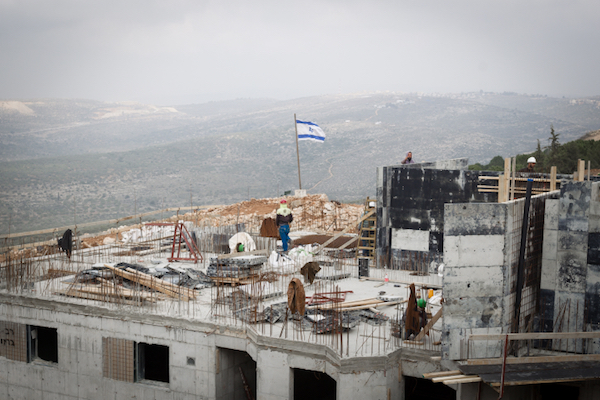A new poll of Palestinians and Israelis finds that with symbolic incentives, a majority on both sides can be convinced to support a two-state solution. But time is only eroding support for two states across the Green Line.

For years, a majority of both Israelis and Palestinians supported a two-state solution in principle. After years of atrophy, large swaths of both societies now believe such a resolution to be impossible. That doubt strongly corresponds to sliding support for two states.
If that trend injures the prospects for peace, the next finding of a recent survey of Israeli and Palestinian attitudes towards the conflict — which I conducted together with Palestinian researcher Dr. Khalil Shikaki — adds insult to injury: a slim majority on both sides still support the two-state solution despite everything.
And yet, the poll found that with realistic policy incentives, the attitudes of many who oppose an agreement are flexible and can be changed. Combined with those who already support two states on both sides, a majority is attainable. If Israeli and Palestinian leaders were to forge an agreement, sign it and throw all of their political behind selling it to their constituents, the public on both sides would very likely come along. But not for long.
The analysis here is based on our poll of 1,200 Palestinians and 900 Israelis, conducted in June and early July, through the PCPSR and the Tami Steinmetz Center at Tel Aviv University. The samples are representative of the total population of each side (Jews and Arabs in Israel, Gaza and the West Bank among Palestinians). The full results, full questionnaire, and all other survey details, can be found here.
Glass half-full
Fifty-three percent of Israelis and 52 percent of Palestinians support the concept of a two-state solution in theory. After all the detailed items of a two-state solution (based on details we know from previous rounds of negotiations) are read to the respondents, support is lower, and similar on both sides: 43 percent among Palestinians, 41 percent among Israelis. However, only a portion of those opposed are hard and inflexible — a large portion would change their minds in exchange for various policy incentives.
For example, if the agreement stipulated that Palestinians would recognize Israel as a Jewish state, with Jewish history and religious attachment, 43 percent of those who first opposed the detailed agreement would change their minds, and total support rises to 58 percent. Among Palestinians, if prisoners held in Israeli jails were released, 56 percent of the opposition to the full agreement would change their mind, and support rises to two-thirds.
These questions represent a sort of laboratory for exploring people’s mindset, not an exact replication of reality. No one can promise that precisely 43 percent of Israelis who oppose a peace package will change their minds suddenly if Palestinians promised to recognize a Jewish state, or what that would do to Palestinian support. This is very much true of the other side: would a majority of the Palestinian opposition really change their minds if prisoners were released, and how many Israelis would drop away in that case?
But one thing is clear: more than 40 percent of Israelis who are not a hard “no” are ready to change their minds for essentially symbolic incentives. Over half of Palestinians express flexibility too, in return for a condition that has nothing to do with destroying Israel or advancing designs of a future single, bi-national state.
Yet it comes as no surprise that lack of trust is an outstanding factor in the current environment. Majorities on each side do not trust the other side – a consistent finding. Perhaps for this reason, another significant incentive that changed minds was the other side changing inciting against them in textbooks. (At our press conference presenting the findings of the joint poll, Dr. Shikaki explained that the Palestinians belief that Israel teaches children to hate them is just as prevalent as the opposite view in Israel.) On both sides, about one-third of the naysayers indicated they would change their mind if hatred and incitement was removed from textbooks.
But all this implies that flexibility of support following hypothetical incentives may be the last remaining factor boosting public acceptance of a two-state solution. Other trends reveal clear danger.
Glass emptying
In the seven years that the PSR has carried out the joint surveys (initially conducted with Hebrew University), support for the overall concept of two states has dropped from 71 percent among Israelis to 53 percent today. Among Jews the current survey shows support at just 47 percent. Among Palestinians, support stood at 57 percent in 2010, but in December 2016 reached a new low of 44 percent. The notable rise in the current survey just brings support back to where it has been in recent years; the overall trend is decidedly downward. When presented with a detailed two-state package, Jewish Israeli support dropped to just 32 percent in the current survey, not even one-third.
Just over half of Palestinians (52 percent) and nearly half of all Israelis (44 percent) think that settlements have spread too much for a two-state solution to be possible. A plurality of Israelis – 49 percent – are not prepared to evacuate even the minimum number of settlers necessary for a two-state solution. But among Israeli Jews, a 54-percent majority (84 percent among those who live over the Green Line), are opposed to such an evacuation.
The perception that a two-state solution isn’t possible is very closely related to the public’s opposition to both the principle and the plan. While it’s not clear whether that perception is a cause or a symptom of opposition to two states, it is a totally accurate reading of the political and physical map. With no progress on a political level, and continued Israeli expansion of both settlements and military presence in the West Bank, the number of people who believe a solution is not viable can be expected to grow, and with them, opposition to that formulation.
Our surveys have begun exploring the likely alternatives more significantly: one equal state, one unequal state (apartheid), and confederation. In the future, these may be the only options left.

